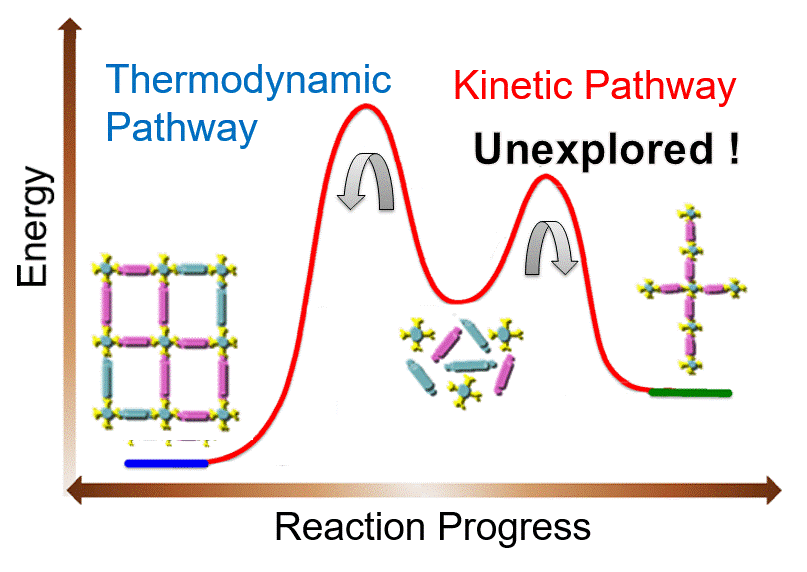Research Contents
-Research on Kinetically Creating Nanospaces-
Conventional porous network complexes formed from ligands and metal ions have been synthesized based on the principle of self-assembly under thermodynamic control. In fact, there are various intermediates in this process. By utilizing these intermediates, we can construct structures different from those produced under thermodynamic control.
Also, by kinetically assembling the structure, we can theoretically generate sites that interact with guests within the pores. Such porous materials are expected to exhibit adsorption, separation, reaction, and physical properties that have not been seen before.
Currently, we are designing and synthesizing original ligands to research unique porous materials with redox properties.
-Reactions Using Nanospaces-
Not only do we synthesize porous materials, but we also study various reactions within the nanospaces of these materials and research their mechanisms. In particular, we conduct research to directly "observe" reactions using in-situ structural analysis, which is one of our main analytical methods.
-Research on Physical Properties of Nanospaces-
Porous network complexes are usually insulators with large band gaps, but they can become conductive by appropriately controlling the redox potential of the ligands. We research the fundamental physical properties that emerge when such ligands are infinitely networked with metal ions. In particular, the study of physical properties is based on solid-state electrochemical measurements, which makes interpretation very difficult, but we are challenging this by combining various methods.
-Device Design Using Nanospaces-
Crystalline materials with nanospaces are promising as device materials because their large surface area is expected to enhance signal intensity for higher sensitivity and substrate selectivity. In particular, the porous materials we are researching show conductivity due to their redox properties. Moreover, they exhibit anisotropy where conductivity changes greatly depending on structure and direction. Taking advantage of these features, we aim to develop new types of sensors by creating thin films formed from porous materials. We are also conducting basic research to examine the sensing mechanism at the molecular level to provide new design guidelines.
-Research on Unknown Structures in Crystalline and Amorphous Phases-
After synthesizing a material, we determine its structure using diffraction methods. Metastable structures often undergo phase transitions, accompanied by significant structural changes and changes in physical properties. The subjects of structural analysis vary from single crystals to crystalline powders and amorphous materials. Therefore, we conduct unknown structure analysis using synchrotron and laboratory X-rays. In particular, powder unknown structure analysis requires specialized crystallographic knowledge because the diffraction information obtained from experiments is theoretically less than that of single-crystal methods. In fact, materials showing interesting properties are often in powder form, and powder unknown structure analysis is a research area that should mature further in the future. We have also newly started research on amorphous phases using total scattering methods and EXAFS, conducting cross-sectional structural studies of solids from macro to nano sizes.